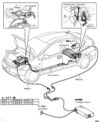|
General Disclaimer: (HV) (DC) injury or death hazard, use at your own risk, may void warranty. |
Battery Chargers
Infrastructure * EVSE * Level 1 * Regulations * At Home * At Workplace * Public Parking * Chargers * Smart Charging
See also W:Battery charger
PHEV Applications
Prius
CalCars believes that most PHEVs need only a 1-1.5 kW charger, able to plug into ordinary 120V, 15A GFI circuits. Since gasoline is available as a range extender, charging need be no faster than overnight.
- CalCars uses a Brusa NLG5 charger from MetricMind.com. This is a $4000, 4kW charger capable of being reprogramed for any chemistry and any voltage output up to 520V. It is invaluable for our experimentation, especially since, for our world's first PRIUS+, we didn't know what would be necessary. A less flexible, lower power, less expensive charger may be more suitable for subsequent conversions.
- Delta-q is taking a strong interest in PHEVs. They are the charger supplier for EDrive Systems' conversions and have begun working with CalCars on creating chargers for both our PbA and Electro Energy NiMH conversions. These are high quality, programmable, and isolated chargers.
- Manzanita Micro MM-PFC PFC-20 Running off Prius HV Pack [1] Charging a BEV. Be aware that these chargers are non-isolated (which scares some people, others don't mind) and is available in 30A, 50A, and multi-50A models. These chargers are used in nearly all the EV's that you see at the drag strip because they are so powerfull, versitile, and field "programmable". They are capable of running from 110vac to 240vac and even DC sources starting at arround 140vdc. So they can charge a battery from 12v to over 300v, act as the DC-DC in a hybrid pack, or even use a hybrids ICE as a generator to charge other DC loads.
Note about Sulfation
RonG: Important new PbA charging information from Tony Goulet at West Coast Batteries Inc. re. Odyssey (and all PbA) batteries (after nearly 40 years of working with PbA batteries off and on, I am still learning more about them):
Sulfation of PbA plates does not only happen at low states-of-charge (SOC) as I used to believe. Sulfur is deposited on the battery's negative plates corresponding to its depth of discharge (DOD). After three days or so this sulfur becomes crystalized and can no longer be removed from the plate by charging. This means that any portion of a PbA battery's capacity that is left in an uncharged state for three days is permanently lost, and the battery now has less capacity! This can happen repeatedly, causing increasing loss of capacity. (Of course, as I already knew, if a PbA battery is left in a very low SOC for long, the sulfur may grow crystal trees that often permanently short out a battery right through its separators.)
The second piece of this tale is that unless a PbA battery has been held at a constant-voltage absorbtion charging stage for 8-12 hours, SOC is less than 100%. If e.g. 97% charge is achieved and the battery is not charged more completely for three days, the uncharged 3% of the capacity will probably be permanently lost to sulfation! It is therefore very important to charge a PbA battery to 100% at least every other day -- and less than a quite long absorbtion charge period (including ~3% overcharge on new batteries, or 10-20% overcharge on older ones) will not suffice!
- Charging Algorithms for Increasing Lead Acid Battery Cycle Life for Electric Vehicles is an interesting (though confusing unless read carefully) paper of NREL research indicating the possibility of greatly extending AGM/VRLA PbA cycle life via unusual charge algorithms.
